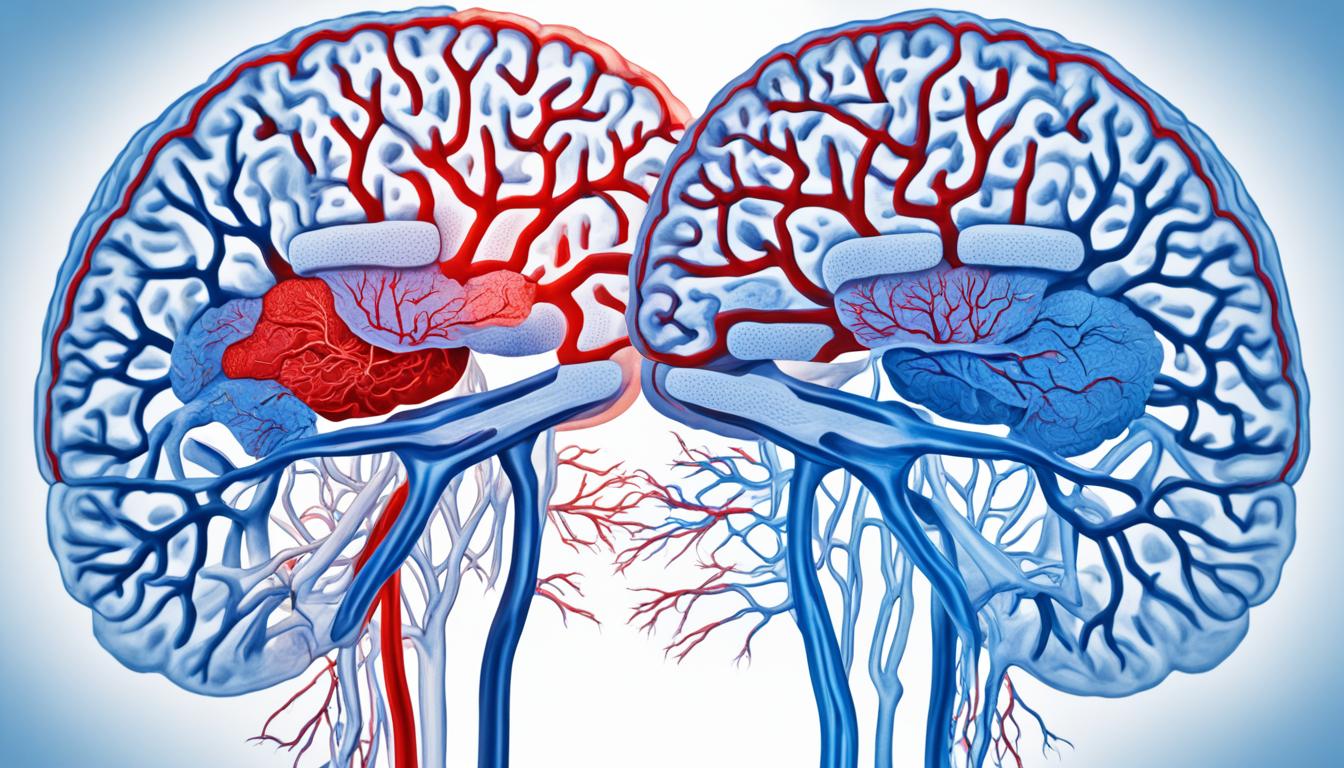Moyamoya disease is a rare brain condition. It affects the internal carotid arteries, causing them to narrow. This leads to restricted blood flow. The risk of strokes, seizures, and other neurological issues goes up. It mainly impacts children, especially those of Asian descent. The exact cause is unknown, but it’s linked to genetic factors and certain medical conditions. These include Down syndrome and sickle cell disease.
To diagnose moyamoya disease, doctors use imaging tests. MRI and cerebral angiography show the narrowed blood vessels clearly. Treatment includes surgery to create new blood vessels. This aims to improve blood flow. Medication is also used to manage symptoms and prevent problems. Scientists are looking into stem cell therapy as another possible treatment.
Key Takeaways:
- Moyamoya disease is a rare condition that affects the internal carotid arteries in the brain.
- The disease primarily affects children, especially those of Asian descent.
- Diagnosis is usually done through imaging tests like MRI and cerebral angiography.
- Treatment options involve surgery to create new blood vessels and using medication to manage symptoms.
- Stem cell therapy is being explored as a potential treatment option for moyamoya disease.
Signs and Associated Conditions of Moyamoya Disease
Moyamoya disease shows several signs and symptoms that can assist in its diagnosis. An ischemic stroke is often the first sign. This happens when a blood clot blocks blood flow to the brain. It can cause issues like one-sided weakness, vision loss, trouble speaking, and seizures. These signs are serious and need quick medical care.
Moyamoya disease can also connect with other health conditions, which we call associated conditions. For example, there is sometimes a link with neurofibromatosis type 1, a condition that leads to nerve tumors. Also, people with Down syndrome, a genetic condition, and sickle cell disease, a blood disorder, have a higher chance of getting moyamoya disease. When moyamoya happens with these conditions, we call it moyamoya syndrome.
| Associated Conditions | Prevalence in Moyamoya Disease |
|---|---|
| Neurofibromatosis type 1 | 5-10% of cases |
| Down syndrome | 2-12% of cases |
| Sickle cell disease | 1-6% of cases |
Note: The prevalence mentioned above is based on available research and may vary.
Diagnosis and Treatment of Moyamoya Disease
Diagnosing moyamoya disease is tricky. Doctors use special tests to see the blood vessels in the brain. This includes MRI, MRA, CT, and cerebral angiography tests.
These tests show how bad the disease is. They also find any other problems and help plan the best treatment.
Imaging tests for the diagnosis of Moyamoya disease:
- Magnetic Resonance Imaging (MRI) uses magnets and radio waves to create brain pictures. It shows the narrowed blood vessels of moyamoya disease.
- Magnetic Resonance Angiography (MRA) looks only at brain blood vessels. It helps spot blockages and see how bad they are in moyamoya patients.
- Computed Tomography (CT) makes detailed brain images with X-rays. It can find out if there’s any bleeding or other issues in the brain.
- Cerebral Angiography shows the brain’s blood vessels using a dye and X-rays. This helps find and check for any blockages.
Treating moyamoya disease tries to make blood flow better and lower stroke risk. Surgeries and medicine are the main treatments used.
Treatment options for Moyamoya disease:
- Direct Revascularization Surgery connects an external blood vessel to an internal one in the brain. This surgery bypasses the blocked vessels to increase blood flow to the brain.
- In Indirect Revascularization Surgery, artery or tissue grafts are placed on the brain’s surface. They help grow new blood vessels over time, improving blood flow.
- Medication can help manage symptoms and prevent clotting. Drugs like calcium channel blockers and anti-clotting medicines are often used.
The treatment chosen depends on the patient’s age, health, and disease stage. A team of specialists helps decide the best plan for each person, including neurosurgeons and neurologists.
| Treatment | Procedure | Advantages |
|---|---|---|
| Direct Revascularization Surgery | Connecting blood vessels from outside to inside the skull |
|
| Indirect Revascularization Surgery | Placing artery or tissue grafts on the brain’s surface |
|
Early diagnosis and the right treatment can help people with moyamoya disease. They might get better blood flow and fewer symptoms. Also, new research is exploring better ways to diagnose and treat this disease, like stem cell therapy.
Prognosis and Future Research of Moyamoya Disease
The future for people with moyamoya disease depends on many things. These include if they had a stroke, their general health, and how well surgery works. For most kids with moyamoya, getting treated early makes a big difference. It lowers the chance of another stroke. But, what happens can differ from person to person.
Scientists are still working to understand moyamoya better. They want to know more about the genes and things in the environment that cause it. They’re also looking into new ways to treat it. One promising area is stem cell therapy. It might help grow new blood vessels in the brain. This could mean a better future for those with moyamoya.
Improving how we diagnose and treat moyamoya is key. Research is looking for better, more specific treatments. Plus, scientists are aiming to get a deeper understanding of this rare disease. By mixing knowledge with new ideas, the goal is to enhance life for people with moyamoya. They are striving for a brighter tomorrow.

